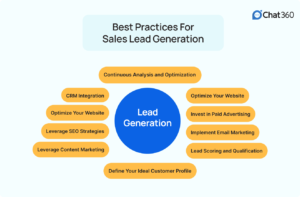
Lead generation is the practice of identifying and attracting potential customers, often referred to as “leads,” for a business’s products or services. It involves various marketing strategies and techniques to engage and capture the interest of individuals or organizations, ultimately nurturing them into becoming customers.
The primary goal is to create a pipeline of qualified prospects who are more likely to make a purchase or take a desired action. Lead generation plays a crucial role in sales and marketing, driving business growth and revenue.
Defining Leads: Potential Customers in Focus
A lead is an individual or prospect who has expressed interest in a company’s products or services and is considered a potential customer. Leads are individuals or organizations that have provided contact information or engaged with the business in some way, indicating they may be interested in making a purchase or learning more about the offerings. Leads are typically nurtured through marketing efforts to convert them into paying customers.
What is a Qualified Lead?
A “qualified” lead is a potential customer who has demonstrated genuine interest in a product or service and meets specific criteria, making them more likely to convert into a paying customer.
Lead Categorization: From Cold Leads to Service Qualified Leads (SQLs)
The table provides an overview of various types of leads, ranging from Cold Leads with minimal prior engagement to Service Qualified Leads (SQLs) ready to engage with specific services. Understanding and categorizing leads based on their level of interest and readiness is essential for effective sales and marketing strategies.
| Type of Lead | Description |
| Cold Leads | – Minimal prior interaction with the business. |
| – Require extensive nurturing and education. | |
| – Typically sourced through broad marketing efforts. | |
| Warm Leads | – Show some interest or engagement with the business. |
| – May have signed up for newsletters or downloaded resources. | |
| – Require further nurturing to move closer to conversion. | |
| Hot Leads | – Highly engaged and actively seeking information. |
| – Often ready to make a purchase or take action. | |
| – Immediate follow-up and personalized communication is crucial. | |
| Marketing Qualified Leads (MQLs) | – Meet specific criteria indicating readiness for sales outreach. |
| – Require further qualification by sales teams. | |
| Sales Qualified Leads (SQLs) | – Thoroughly vetted and assessed by sales teams. |
| – Express clear intent to purchase or take action. | |
| – Ready for direct sales engagement and conversion. | |
| Product Qualified Leads (PQLs) | – Users of a free or trial version of a product. |
| – Show interest in upgrading or expanding usage. | |
| – Ideal candidates for upselling or converting to paid users. | |
| Subscriber Leads | – Individuals who have subscribed to newsletters or updates. |
| – Indicate interest in staying informed about the business. | |
| – Potential for nurturing into customers over time. | |
| Referral Leads | – Referred by existing customers or partners. |
| – Come with a level of trust due to the referral source. | |
| – May have a shorter sales cycle due to trust and credibility. | |
| Inbound Leads | – Initiate contact with the business through inquiries or visits. |
| – Self-driven interest often generated through marketing efforts. | |
| – Require timely and personalized responses. | |
| Outbound Leads | – Identified and targeted by the business through outreach. |
| – May include cold calls or email campaigns. | |
| – Require a compelling value proposition to capture interest. | |
| Service Qualified Leads (SQLs) | – Show interest in the services offered by the business. |
| – Undergo qualification specific to the services provided. | |
| – Ready or nearing readiness to engage with the offered services. |
The Significance of Lead Generation: Fueling Growth, Sales, and Marketing Strategies
Lead generation stands as an essential component for sustained business growth.
Firstly, it identifies potential customers, allowing businesses to focus their efforts on those most likely to convert.
Secondly, it fosters a robust sales pipeline, ensuring a consistent influx of prospects to engage with, ultimately increasing sales and revenue.
Finally, it offers valuable data insights that refine marketing strategies, enabling businesses to adapt and thrive in competitive markets.
What is Inbound vs. Outbound Marketing in Lead Generation
Inbound marketing and outbound marketing are two distinct approaches to reaching and engaging with audiences in the world of marketing.
Inbound Marketing focuses on drawing potential customers in by creating valuable content, optimizing for search engines, and utilizing social media. It aims to build trust and establish relationships with prospects, who actively seek out relevant information or solutions.
Outbound Marketing, on the other hand, involves pushing a message out to a broader audience through tactics like advertising, direct mail, or cold calling. It’s more traditional and interruption-based, aiming to capture attention and generate immediate interest.
Each approach has its strengths and applications, and successful marketing strategies often blend elements of both to achieve a well-rounded and effective campaign.
Lead Generation in the Digital Age: Harnessing AI and Chatbots
In the digital age, lead generation has undergone a profound transformation, leveraging advanced technologies like Artificial Intelligence (AI) and chatbots to enhance efficiency and effectiveness.
AI-powered algorithms analyze vast amounts of data, allowing businesses to pinpoint and target potential customers with remarkable precision. Chatbots, on the other hand, provide real-time engagement, answering inquiries, and collecting valuable information from website visitors.
Together, these tools streamline lead generation, enabling businesses to nurture and convert leads in a more personalized and data-driven manner, ultimately driving growth in the digital era.
Best Practices for Sales Lead Generation
Effective lead generation is a crucial aspect of successful sales strategies. Here are some best practices to optimize your sales lead generation efforts:

Define Your Ideal Customer Profile:
Start by clearly defining your target audience. Understanding who your ideal customers are will help you tailor your approach and messaging accordingly.
Leverage Content Marketing:
Create valuable and relevant content that addresses the pain points and needs of your audience. Blogs, ebooks, webinars, and whitepapers can attract and engage potential leads.
Optimize Your Website:
Ensure that your website offers a user-friendly and effortless experience for visitors. Implement lead capture forms and strategically placed calls-to-action (CTAs) to convert visitors into leads.
Utilize Social Media:
Use social media platforms to build brand awareness and engage with potential leads. Share valuable content, participate in discussions, and use targeted ads to reach your audience.
Implement Email Marketing:
Craft compelling email campaigns to nurture and convert leads. Customize your messages, divide your email list into segments, and offer valuable content to engage your audience effectively.
Leverage SEO Strategies:
Optimize your website for search engines to increase organic traffic and attract potential leads. Use relevant keywords, create quality backlinks, and improve website speed and mobile-friendliness.
Invest in Paid Advertising:
Consider using pay-per-click (PPC) advertising on platforms like Google Ads and social media to reach a wider audience. Tailor your ads to specific demographics, interests, and behaviors for precise targeting and more effective marketing.
Lead Scoring and Qualification:
Implement lead scoring to prioritize and qualify leads. Not all leads are equal, and focusing on the most promising ones can improve conversion rates.
CRM Integration:
Integrate a Customer Relationship Management (CRM) system to manage and track leads efficiently. This ensures timely follow-ups and helps in maintaining lead data.
Continuous Analysis and Optimization:
Regularly analyze your lead generation efforts. Monitor key performance indicators (KPIs), track conversions, and adjust your strategies based on the results.
Innovative Strategies for Lead Generation with AI-Powered Chatbots
Lead generation is a cornerstone of successful marketing, and in the digital age, harnessing AI-powered tools like chatbots has become a game-changer. These innovative bots can be seamlessly integrated across various platforms, including social media giants like Whatsapp, Instagram, and Facebook, as well as your website and CRM tools, to supercharge your lead generation efforts.
Social Media Integration:
AI chatbots integrated with social media platforms enable personalized interactions with potential leads. They can answer inquiries, provide information, and even assist with transactions, all within the familiar social media environment. This not only engages users but also captures leads directly through these platforms.
Website Integration:
Placing chatbots on your website allows visitors to receive instant responses to queries, guiding them through the sales funnel in real-time. AI-driven chatbots analyze user behavior to offer tailored content and product recommendations, increasing the chances of lead conversion.
CRM Tool Integration:
Integration with CRM tools streamlines lead management. Chatbots can capture lead data, qualify prospects, and enter them into your CRM system, ensuring seamless tracking, nurturing, and follow-ups.
Personalization and Automation:
AI chatbots use data analytics and machine learning to provide personalized experiences. They can send targeted messages, recommend products, and follow up with leads automatically, saving time and resources while maintaining engagement.
By incorporating AI-powered chatbots into your lead generation strategies across multiple channels, businesses can achieve greater efficiency, personalized engagement, and improved conversion rates, ultimately driving growth in the digital landscape.
Chat360 can significantly enhance lead generation efforts through its AI-powered chatbot capabilities.
Chat360 plays a pivotal role in modern business operations as a versatile AI-powered chatbot platform. It acts as a 24/7 virtual assistant, offering immediate customer support, answering inquiries, and capturing leads across multiple platforms, including websites and social media.
Its AI-driven capabilities streamline communication, enhance user experiences, and drive growth by facilitating lead generation and customer engagement.
24/7 Availability:
Chatbots are available round the clock, engaging with website visitors and social media users even outside regular business hours. This ensures no potential leads are missed due to time zone differences or operating hours.
Instant Responses:
Chatbots provide immediate responses to inquiries and engage users in real-time conversations. This quick and efficient interaction increases user engagement and captures leads at the moment of interest.
Qualification and Segmentation:
Chatbots can ask qualifying questions to determine the level of interest and segment leads accordingly. This helps in prioritizing high-quality leads for follow-up.
Personalization:
Chatbots use AI to analyze user behavior and preferences, offering personalized product recommendations or content. Personalization fosters a deeper connection with leads and increases the likelihood of conversion.
Lead Data Collection:
Chatbots can collect essential lead information, including contact details, preferences, and pain points. This data is valuable for further nurturing and targeted marketing campaigns.
Multi-Platform Integration:
Chat360 can be integrated with various platforms, including websites, social media (e.g., Facebook, Instagram, Whatsapp), and CRM systems. This seamless integration ensures that leads from different sources are centralized for easy management.
Lead Nurturing:
Chatbots can initiate follow-up conversations, send relevant content, and nurture leads over time. This continuous engagement keeps leads warm and informed until they are ready to convert.
Automated Follow-ups:
Chatbots can send automated follow-up messages or emails to remind leads of important actions or deadlines, increasing conversion rates.
Scalability:
Chatbots can handle multiple conversations simultaneously, ensuring that lead generation efforts can scale without the need for a proportional increase in human resources.
Data Insights:
Chat360 provides valuable data insights and analytics on user interactions. This data can be used to refine lead generation strategies and improve chatbot performance continually.
By leveraging Chat360’s AI-powered chatbot capabilities, businesses can streamline lead generation processes, capture leads efficiently, provide personalized experiences, and ultimately increase conversion rates, driving growth and revenue.
Sign up for a free trial today!